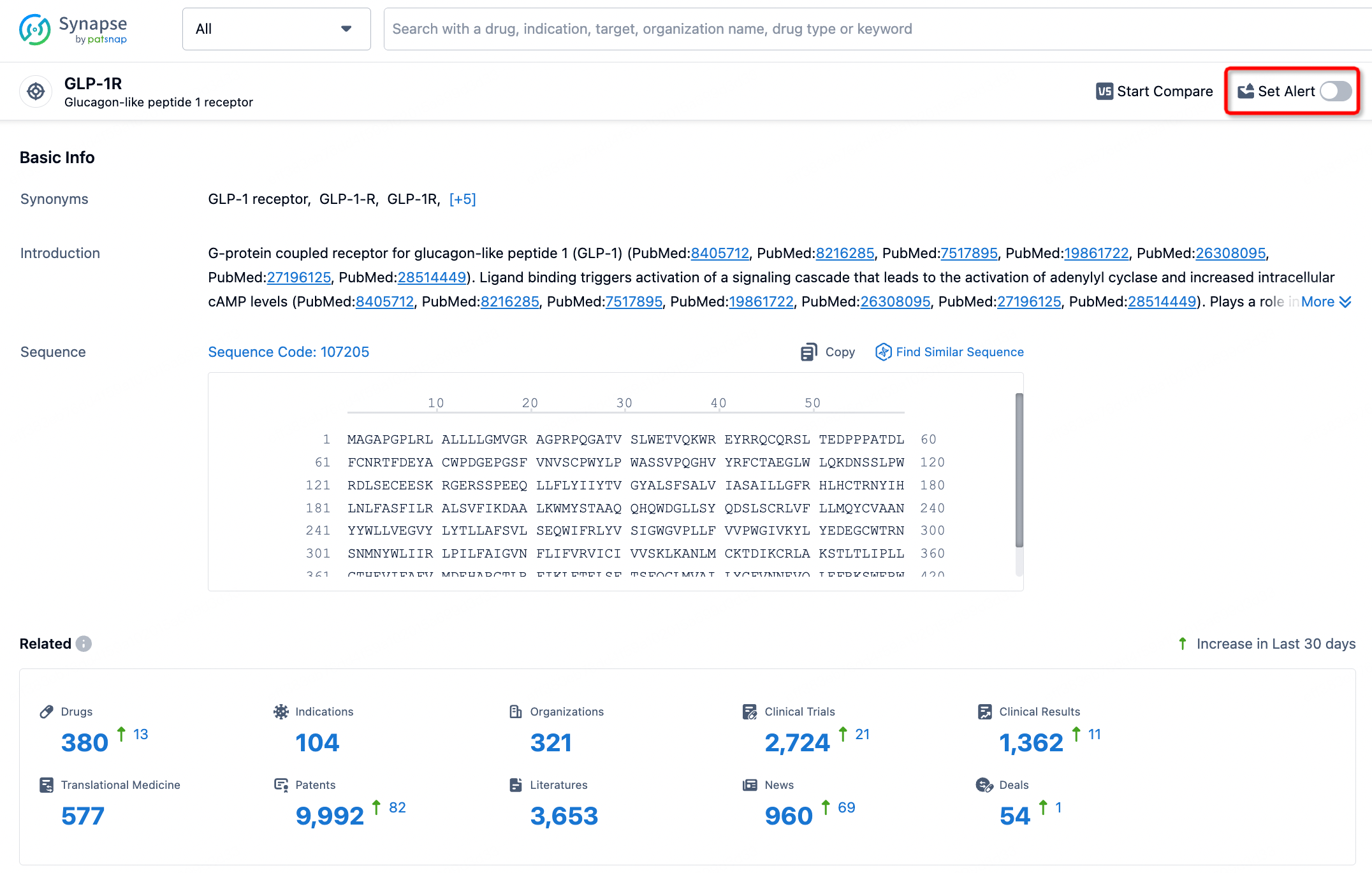Request Demo
What are SLC6A19 inhibitors and how do they work?
25 June 2024
SLC6A19 is a gene that encodes for a protein known as B^0AT1, which is primarily involved in the transport of neutral amino acids across cell membranes in the kidneys and intestines. This protein plays a crucial role in the absorption and reabsorption of essential amino acids like leucine, isoleucine, and valine. Mutations in the SLC6A19 gene can lead to a disorder known as Hartnup disease, characterized by defective amino acid transport, resulting in a variety of symptoms ranging from dermatological issues to neurological problems. Recent research has focused on the development of SLC6A19 inhibitors, compounds that specifically target and modulate the activity of this transporter. These inhibitors hold potential for therapeutic applications in several medical conditions, thereby garnering significant scientific and clinical interest.
SLC6A19 inhibitors work by selectively binding to the B^0AT1 transporter, thereby preventing the uptake of neutral amino acids into cells. This inhibition can modulate various physiological systems and pathways that depend on amino acid availability. For instance, by limiting the absorption of certain amino acids from the diet, these inhibitors can alter the metabolic profile and influence systemic levels of amino acids and their metabolites.
One of the primary mechanisms through which SLC6A19 inhibitors exert their effects is competitive inhibition. These compounds compete with natural substrates for binding sites on the B^0AT1 transporter, effectively reducing the transporter's efficiency. This competitive inhibition can be highly selective, allowing for precise modulation of specific amino acids without broadly disrupting other transport processes. Additionally, some SLC6A19 inhibitors might work through allosteric modulation, where they bind to a site different from the substrate-binding site, inducing conformational changes in the transporter that reduce its activity.
The implications of SLC6A19 inhibition extend beyond mere amino acid transport. Amino acids serve as building blocks for proteins and are precursors for key metabolic intermediates. Thus, regulating their transport can have downstream effects on protein synthesis, metabolic pathways, and even signaling cascades. For example, branched-chain amino acids (BCAAs) like leucine play a pivotal role in muscle protein synthesis and energy metabolism. By controlling their absorption through SLC6A19 inhibition, it is possible to influence muscle physiology and metabolic health.
SLC6A19 inhibitors have shown potential in a variety of therapeutic contexts. One of the most promising applications is in the management of metabolic disorders. For instance, conditions like obesity and type 2 diabetes are often associated with elevated levels of BCAAs, which can exacerbate insulin resistance and metabolic dysfunction. By inhibiting SLC6A19, it may be possible to lower BCAA levels and improve insulin sensitivity, thereby offering a novel approach to managing these metabolic diseases.
Another significant application is in the treatment of Hartnup disease, the very condition linked to SLC6A19 mutations. In patients with Hartnup disease, defective amino acid transport leads to a range of symptoms, including pellagra-like skin rashes, ataxia, and neuropsychiatric issues. While the condition is generally managed through dietary modifications and supplementation, SLC6A19 inhibitors could offer a more targeted therapeutic strategy. By modulating the activity of the remaining functional transporters, these inhibitors might help normalize amino acid levels and alleviate symptoms.
Moreover, SLC6A19 inhibitors could have implications in oncology. Certain cancer cells exhibit altered amino acid metabolism, relying heavily on specific amino acids for growth and survival. By targeting amino acid transporters like B^0AT1, it might be possible to disrupt the metabolic dependencies of cancer cells, thereby inhibiting their proliferation and survival. This approach could complement existing cancer therapies and provide a new avenue for anti-cancer strategies.
In conclusion, SLC6A19 inhibitors represent a promising frontier in both basic and clinical research. By elucidating their mechanisms of action and exploring their therapeutic potential, scientists and clinicians can uncover new strategies for managing a range of diseases. Whether in metabolic disorders, genetic conditions like Hartnup disease, or even cancer, these inhibitors hold the promise of innovative treatments that precisely target underlying biological pathways. As research progresses, the full scope of their applications will undoubtedly become clearer, paving the way for novel therapeutic interventions.
SLC6A19 inhibitors work by selectively binding to the B^0AT1 transporter, thereby preventing the uptake of neutral amino acids into cells. This inhibition can modulate various physiological systems and pathways that depend on amino acid availability. For instance, by limiting the absorption of certain amino acids from the diet, these inhibitors can alter the metabolic profile and influence systemic levels of amino acids and their metabolites.
One of the primary mechanisms through which SLC6A19 inhibitors exert their effects is competitive inhibition. These compounds compete with natural substrates for binding sites on the B^0AT1 transporter, effectively reducing the transporter's efficiency. This competitive inhibition can be highly selective, allowing for precise modulation of specific amino acids without broadly disrupting other transport processes. Additionally, some SLC6A19 inhibitors might work through allosteric modulation, where they bind to a site different from the substrate-binding site, inducing conformational changes in the transporter that reduce its activity.
The implications of SLC6A19 inhibition extend beyond mere amino acid transport. Amino acids serve as building blocks for proteins and are precursors for key metabolic intermediates. Thus, regulating their transport can have downstream effects on protein synthesis, metabolic pathways, and even signaling cascades. For example, branched-chain amino acids (BCAAs) like leucine play a pivotal role in muscle protein synthesis and energy metabolism. By controlling their absorption through SLC6A19 inhibition, it is possible to influence muscle physiology and metabolic health.
SLC6A19 inhibitors have shown potential in a variety of therapeutic contexts. One of the most promising applications is in the management of metabolic disorders. For instance, conditions like obesity and type 2 diabetes are often associated with elevated levels of BCAAs, which can exacerbate insulin resistance and metabolic dysfunction. By inhibiting SLC6A19, it may be possible to lower BCAA levels and improve insulin sensitivity, thereby offering a novel approach to managing these metabolic diseases.
Another significant application is in the treatment of Hartnup disease, the very condition linked to SLC6A19 mutations. In patients with Hartnup disease, defective amino acid transport leads to a range of symptoms, including pellagra-like skin rashes, ataxia, and neuropsychiatric issues. While the condition is generally managed through dietary modifications and supplementation, SLC6A19 inhibitors could offer a more targeted therapeutic strategy. By modulating the activity of the remaining functional transporters, these inhibitors might help normalize amino acid levels and alleviate symptoms.
Moreover, SLC6A19 inhibitors could have implications in oncology. Certain cancer cells exhibit altered amino acid metabolism, relying heavily on specific amino acids for growth and survival. By targeting amino acid transporters like B^0AT1, it might be possible to disrupt the metabolic dependencies of cancer cells, thereby inhibiting their proliferation and survival. This approach could complement existing cancer therapies and provide a new avenue for anti-cancer strategies.
In conclusion, SLC6A19 inhibitors represent a promising frontier in both basic and clinical research. By elucidating their mechanisms of action and exploring their therapeutic potential, scientists and clinicians can uncover new strategies for managing a range of diseases. Whether in metabolic disorders, genetic conditions like Hartnup disease, or even cancer, these inhibitors hold the promise of innovative treatments that precisely target underlying biological pathways. As research progresses, the full scope of their applications will undoubtedly become clearer, paving the way for novel therapeutic interventions.
How to obtain the latest development progress of all targets?
In the Synapse database, you can stay updated on the latest research and development advances of all targets. This service is accessible anytime and anywhere, with updates available daily or weekly. Use the "Set Alert" function to stay informed. Click on the image below to embark on a brand new journey of drug discovery!
AI Agents Built for Biopharma Breakthroughs
Accelerate discovery. Empower decisions. Transform outcomes.
Get started for free today!
Accelerate Strategic R&D decision making with Synapse, PatSnap’s AI-powered Connected Innovation Intelligence Platform Built for Life Sciences Professionals.
Start your data trial now!
Synapse data is also accessible to external entities via APIs or data packages. Empower better decisions with the latest in pharmaceutical intelligence.


